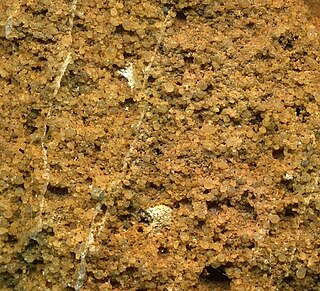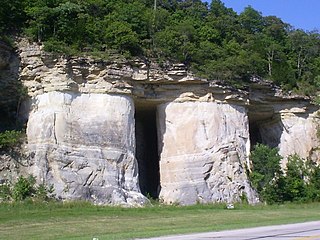| Cason Shale Stratigraphic range: Ordovician-Silurian | |
|---|---|
| Type | Formation |
| Unit of | none |
| Underlies | Brassfield Limestone |
| Overlies | Fernvale Limestone |
| Thickness | up to appx. 23 feet [1] |
| Lithology | |
| Primary | Shale |
| Location | |
| Region | Arkansas |
| Country | United States |
| Type section | |
| Named for | Cason tract and mine, near Batesville, Independence County, Arkansas |
| Named by | Henry Shaler Williams [2] |
The Cason Shale is a Late Ordovician to Middle Silurian geologic formation in the Ozark Plateaus of Arkansas. [1] The name was introduced in 1894 by Henry Shaler Williams in his study of Arkansas. [2] Williams designated a type locality at what was known as the Cason tract and mine, near Batesville, Independence County, Arkansas, however, he did not assign a stratotype. As of 2017, a reference section has not been designated for this unit.

The Fayetteville Shale is a geologic formation of Mississippian age composed of tight shale within the Arkoma Basin of Arkansas and Oklahoma. It is named for the city of Fayetteville, Arkansas, and requires hydraulic fracturing to release the natural gas contained within.

The Kimmswick Limestone is an Ordovician geologic formation in Arkansas, Illinois and Missouri. Fossils occurring in the Kimmswick include corals, bryozoans, brachiopods, conodonts, trilobites, crinoids and mollusks.
The Fernvale Limestone is a geologic formation in Alabama, Arkansas, Illinois, Missouri, Oklahoma, and Tennessee. It preserves fossils dating back to the Ordovician period.
The Collier Shale is a geologic formation in the Ouachita Mountains of Arkansas and Oklahoma. Dating from the Late Cambrian to Early Ordovician periods, the Collier Shale is the oldest stratigraphic unit exposed in Arkansas. First described in 1892, this unit was not named until 1909 by Albert Homer Purdue in his study of the Ouachita Mountains of Arkansas. Purdue assigned the type locality to the headwaters of Collier Creek in Montgomery County, Arkansas, but did not designate a stratotype. As of 2017, a reference section for this unit has yet to be designated.
The Hindsville Formation, or Hindsville Limestone Member of the Batesville Formation, is a geologic unit in northern Arkansas and eastern Oklahoma that dates to the Chesterian Series of the late Mississippian. Named for the town of Hindsville in Madison County, Arkansas, this unit is recognized as a member of the Batesville Formation in Arkansas and a geologic formation in Oklahoma. Although, some workers have proposed raising the rank of this interval in Arkansas to formation status. Both the Batesville and Hindsville Formations overlie the Moorefield Formation and underlie the Fayetteville Shale.
The St. Clair Limestone is a geologic formation in Arkansas, Indiana, Missouri, and Oklahoma. It preserves fossils dating back to the Silurian period. This high density, high magnisium dolomitic limestone was originally classified as a marble in Oklahoma due to the fact that it would hold a high polish, hence Marble City.
The Al Rose Formation is a geologic formation in California. It consists mostly of siltstone, mudstone and shale, with some chert and occasional limestone. In it are found graptolite and trilobite fossils dating back to the Ordovician period.
The Badger Flat Limestone is a limestone geologic formation in California.
The Mazarn Shale is an Early Ordovician geologic formation in the Ouachita Mountains of Arkansas and Oklahoma. This interval was first described in 1892, but remained unnamed until 1918 as part of a study by U.S. Geological Survey geologist Hugh Dinsmore Miser.

The Blakely Sandstone is a Middle Ordovician geologic formation in the Ouachita Mountains of Arkansas and Oklahoma. First described in 1892, this unit was not named until 1909 by Albert Homer Purdue in his study of the Ouachita Mountains of Arkansas. Purdue had initially named this unit the Caddo Shale at a 1907 Geological Society of America meeting, but later redefined and renamed the unit as the Ouachita Shale. He again renamed the unit to the Blakely Sandstone in a letter to Edward Oscar Ulrich, to which Ulrich used in a 1911 publication, becoming the first reference using this name. Ulrich assigned the Blakely Mountain in Garland County, Arkansas as the type locality, but did not designate a stratotype. As of 2017, a reference section for this unit has yet to be designated.
The Womble Shale is a Middle Ordovician geologic formation in the Ouachita Mountains of Arkansas and Oklahoma. First described in 1892, this unit was not named until 1909 by Albert Homer Purdue in his study of the Ouachita Mountains of Arkansas, where he named this unit as part of the upper Ouachita Shale and the Stringtown Shale. In 1918, U.S. Geological Survey geologist, Hugh Dinsmore Miser, replaced Purdue's nomenclature with the Womble Shale. Miser assigned the town of Womble in Montgomery County, Arkansas as the type locality. As of 2017, a reference section for this unit has yet to be designated.
The Bigfork Chert is a Middle to Late Ordovician geologic formation in the Ouachita Mountains of Arkansas and Oklahoma. First described in 1892, this unit was not named until 1909 by Albert Homer Purdue in his study of the Ouachita Mountains of Arkansas. Purdue assigned the town of Big Fork in Montgomery County, Arkansas as the type locality, but did not designate a stratotype. As of 2017, a reference section for this unit has yet to be designated. The Bigfork Chert is known to produce planerite, turquoise, variscite, and wavellite minerals.
The Polk Creek Shale is a Late Ordovician geologic formation in the Ouachita Mountains of Arkansas and Oklahoma. First described in 1892, this unit was not named until 1909 by Albert Homer Purdue in his study of the Ouachita Mountains of Arkansas. Purdue assigned Polk Creek in Montgomery County, Arkansas as the type locality, but did not designate a stratotype. As of 2017, a reference section for this unit has yet to be designated.
The Blaylock Sandstone is a Silurian geologic formation in the Ouachita Mountains of Arkansas and Oklahoma. First described in 1892, this unit was not named until 1909 by Albert Homer Purdue in his study of the Ouachita Mountains of Arkansas. Purdue assigned the Blaylock Mountain in Montgomery County, Arkansas as the type locality, but did not designate a stratotype. As of 2017, a reference section for this unit has yet to be designated.
The Missouri Mountain Shale is a Silurian geologic formation in the Ouachita Mountains of Arkansas and Oklahoma. First described in 1892, this unit was not named until 1909 by Albert Homer Purdue in his study of the Ouachita Mountains of Arkansas. Purdue assigned the Missouri Mountains in Polk and Montgomery counties, Arkansas as the type locality, but did not designate a stratotype. As of 2017, a reference section for this unit has yet to be designated.
The Stanley Shale, or Stanley Group, is a Mississippian stratigraphic unit in the Ouachita Mountains of Arkansas and Oklahoma. First described in Arkansas in 1892, this unit was not named until 1902 by J.A. Taff in his study of the Ouachita Mountains of Oklahoma. Taff assigned the town of Stanley in Pushmataha County, Oklahoma as the type locality, but did not designate a stratotype. After introduction into Arkansas in 1909 by Albert Homer Purdue, the unit was redefined in 1918, when the formation known as the Fork Mountain Slate was abandoned and partially combined into the Stanley Shale. As of 2017, a reference section for the Stanley Shale has yet to be designated.

The Joachim Dolomite is a Middle Ordovician geologic formation in Arkansas, Illinois, and Missouri. The name was first introduced in 1894 by Arthur Winslow in his study of the geology of Missouri. Winslow designated a stratotype along Plattin Creek, which was misidentified as Joachim Creek, in Jefferson County. The name was introduced into Arkansas in 1911, replacing part of the, now abandoned, Izard Limestone.
The Plattin Limestone is a Middle Ordovician geologic formation in Arkansas, Illinois, and Missouri. The name was first introduced in 1904 by Edward Oscar Ulrich in his study of the geology of Missouri. A type locality was designated at the mouth of the Plattin Creek in Jefferson County, Missouri, however a stratotype was not assigned. As of 2017, a reference section has not been designated. The name was introduced into Arkansas in 1927, replacing part of the, now abandoned, Izard Limestone.
The Lafferty Limestone is a Middle to Late Silurian geologic formation in the Ozark Plateaus of Arkansas. The name was introduced in 1921 by Hugh Dinsmore Miser in his study of Arkansas, replacing part of the upper St. Clair Limestone. Miser designated a type locality at Tate Spring, located 1.25 miles north of the site of the old Penters Bluff railroad station in Izard County, Arkansas, however, he did not assign a stratotype. As of 2017, a reference section has not been designated for this unit.
The Penters Chert is a Devonian geologic formation in the Ozark Plateaus of Arkansas. The name was introduced in 1921 by Hugh Dinsmore Miser in his study of Arkansas. Miser designated a type locality near the old Penters Bluff railroad station in Izard County, Arkansas, however, he did not assign a stratotype. As of 2017, a reference section has not been designated for this unit.